แอปพลิเคชันยอดนิยมส่วนใหญ่มีโหมดปลอดภัยที่ช่วยให้ผู้ใช้สามารถเรียกใช้โปรแกรมด้วยฟังก์ชันการทำงานที่ จำกัด เมื่อสิ่งต่างๆไม่ทำงานเท่าที่ควร ในกรณีนี้กับOutlook - โปรแกรมจัดการอีเมลที่ซับซ้อนซึ่งใช้Safe Modeเพื่อหลีกเลี่ยงปัญหาต่างๆมากมายที่ทำให้ไม่สามารถเริ่มต้นได้ คุณอาจเปิด Outlook ใน Safe Mode โดยตั้งใจ แต่อาจเริ่มในโหมดนี้ด้วยตัวเอง

เว้นแต่คุณจะเริ่มSafe Modeด้วยตนเองไม่ว่าด้วยเหตุผลใดก็ตามฉันจะไม่แนะนำให้คุณใช้ Outlook ในโหมดนี้ต่อไป คุณจะไม่สามารถบันทึกเทมเพลตค่ากำหนดและจะไม่สามารถใช้สมาร์ทแท็กได้ หากคุณอยู่ในสถานการณ์เช่นนี้ขอแนะนำให้คุณใช้ Safe Mode เป็นเครื่องมือวินิจฉัยและแก้ไขปัญหาของคุณ
เมื่อใดที่ Safe Mode ใช้ใน OutLook
Outlook จะอัปเดตรีจิสทรีของระบบเป็นประจำเพื่อให้ส่วนขยายใหม่ที่คุณติดตั้งทำงานได้ตามที่ควร หากโปรแกรมตรวจพบปัญหาในงานเปิดตัวที่ป้องกันไม่ให้มันจากการทำงานก็จะหันไปเซฟโหมด โดยปกติจะเกิดขึ้นทันทีหลังจากที่คุณติดตั้งโปรแกรมเสริมใหม่ที่เล่นกับ Outlook เวอร์ชันของคุณได้ไม่ดี
คุณสามารถเรียกเซฟโหมดตัวเองด้วยการเปิดRunหน้าต่างและการพิมพ์ของ Outlook / ความปลอดภัยและกดปุ่มตกลง

ในกรณีที่ Outlook เริ่มทำงานโดยอัตโนมัติในSafe Modeมักเป็นสัญญาณว่ามีบางอย่างทำงานไม่ถูกต้อง บางครั้ง Outlook จะจัดการเพื่อระบุส่วนประกอบ Add-in ที่ขัดขวางไม่ให้ Outlook เริ่มทำงานตามปกติ หากระบบขอให้คุณปิดการใช้งานส่วนประกอบที่ผิดพลาดให้ลองดูว่า Outlook สามารถเริ่มทำงานได้ตามปกติหรือไม่

ทริกเกอร์โหมดปลอดภัยที่เป็นไปได้
หากคุณใช้เวอร์ชัน 2010 ปัญหาของคุณน่าจะเกิดจากการอัปเดต KB3114409ที่ทำให้ Outlook เริ่มทำงานใน Safe Mode และเปลี่ยนกลับเป็นการตั้งค่าเริ่มต้น ในกรณีที่คุณใช้ Outlook เวอร์ชันเก่าเช่น 2007 หรือ 2003 ปัญหาของคุณอาจเกี่ยวข้องกับบริการWindows Search ผิด add-in ที่ยังสามารถขัดแย้งกับรุ่น Outlook ของคุณไปยังจุดที่คุณจะบังคับให้มันจะเริ่มต้นในSafe Mode
สิ่งเหล่านี้เป็นเพียงตัวการก่อเหตุ 3 อย่าง แต่สาเหตุอาจมาจากหลายแห่ง
ด้านล่างนี้คุณจะมีคอลเลกชันของการแก้ไขที่ได้ช่วยแล้วเป็นจำนวนมากของผู้ใช้ป้องกันไม่ให้ Outlook จากทำงานในเซฟโหมด ทำตามวิธีการด้านบนตามลำดับเวอร์ชัน Outlook ของคุณจนกว่าคุณจะพบวิธีแก้ไขที่ช่วยแก้ปัญหาของคุณได้
วิธีที่ 1: การปิดใช้งาน Add-in ใน Safe Mode (เวอร์ชัน Outlook ทั้งหมด)
นี้เป็นธรรมดาที่เกิดขึ้นในทุกรุ่น Outlook จากOutlook 2007ไปยัง Outlook 2016 สิ่งนี้เกิดขึ้นเนื่องจาก Add-in บางตัวจะขัดแย้งกับเวอร์ชัน Outlook ของคุณ สิ่งนี้มีแนวโน้มมากขึ้นด้วยการติดตั้ง Add-in ที่ล้าสมัยใน Outlook เวอร์ชันล่าสุด
หมายเหตุ:ถ้าคุณติดตั้งAdd-in ABBYY FineReaderก่อนที่ข้อผิดพลาดนี้จะเริ่มเกิดขึ้นให้ทำตามขั้นตอนด้านล่างเพื่อลบ Add-in ออกจากเวอร์ชัน Outlook ของคุณ
- ยืนยันว่า Outlook อยู่ใน Safe Mode โดยตรวจสอบว่าไอคอนในแถบงานของคุณมีเครื่องหมายอัศเจรีย์หรือไม่

หมายเหตุ:คุณสามารถยืนยันได้โดยดูว่าคุณเห็น (Safe Mode) ที่ส่วนบนสุดของหน้าจอหรือไม่

- ตอนนี้ขยายไฟล์แท็บและคลิกที่ตัวเลือก

- ตอนนี้คลิกที่แท็บAdd-in จากนั้นเข้าถึงเมนูแบบเลื่อนลงถัดจากจัดการและเลือกCOM Add-inจากรายการ คลิกที่ไปเพื่อดำเนินการต่อ
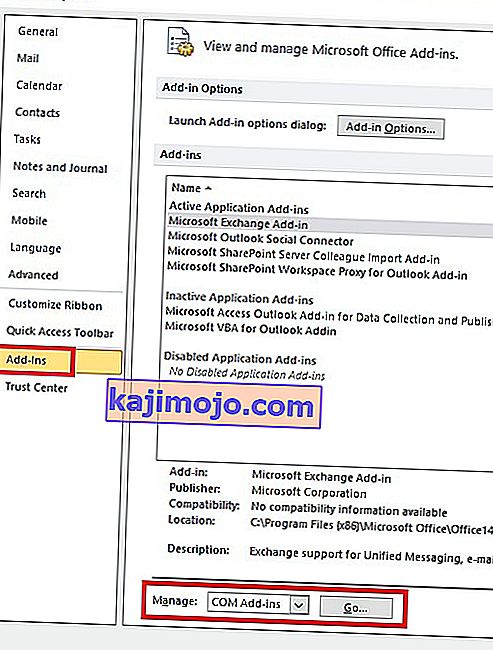
- ณ จุดนี้คุณควรจับภาพหน้าจอของรายการ Add-in และบันทึกไว้ในที่ที่สะดวก วิธีนี้จะช่วยคุณคืนค่าการกำหนดค่าตามปกติของ Outlook ของคุณหากเกิดความผิดปกติใด ๆ ขึ้นหลังจากที่คุณปิดใช้งาน Add-in
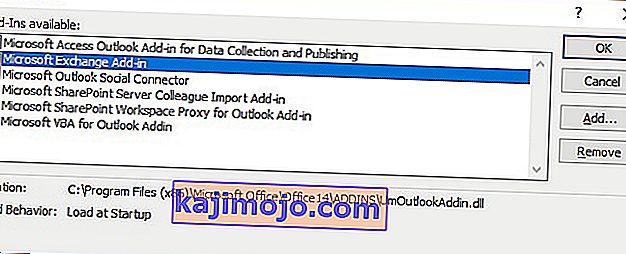
- ปิดการใช้งานแต่ละรายการ (ช่องทำเครื่องหมายเลือกที่ชัดเจน) และกดตกลง
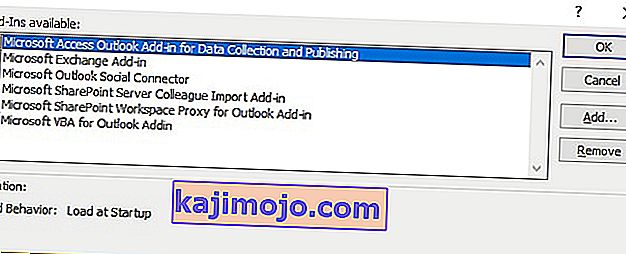 หมายเหตุ:อย่าตีลบเพียง แต่ ก่อนอื่นเราต้องยืนยันว่าพวกเขาเป็นสาเหตุของปัญหา
หมายเหตุ:อย่าตีลบเพียง แต่ ก่อนอื่นเราต้องยืนยันว่าพวกเขาเป็นสาเหตุของปัญหา - ปิด Outlook แล้วเปิดสำรองอีกครั้ง หากโปรแกรมบู๊ตในโหมดปกติแสดงว่าปัญหาของคุณได้รับการแก้ไขแล้ว
หมายเหตุ: ในกรณีที่มันยังคงเริ่มต้นในSafe Modeไปที่ไฟล์ตัวเลือก> เพิ่มอินและเปิดใช้งาน Add-ins เราคนพิการในขั้นตอนที่ 5 และย้ายไปยังวิธีที่ 2
- กลับไปที่ไฟล์> ตัวเลือก> Add-inและเปิดใช้งาน Add-in ทีละรายการอย่างเป็นระบบจนกว่าคุณจะเปิดเผยสิ่งที่ทำให้เกิดความขัดแย้ง
- เลือกและกดลบ
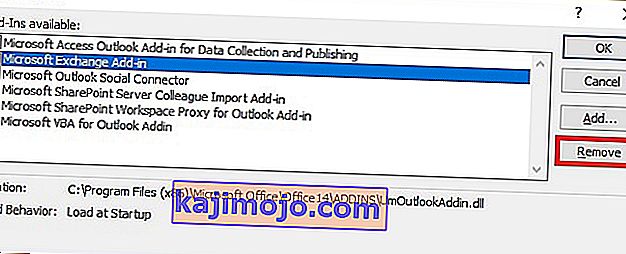
- รีสตาร์ท Outlook และดูว่าบู๊ตในโหมดปกติหรือไม่
วิธีที่ 2: กู้คืนคอมพิวเตอร์ของคุณโดยใช้ System Restore (เวอร์ชัน Outlook ทั้งหมด)
การคืนค่าระบบเป็นคุณลักษณะของ Windows ที่ช่วยให้ผู้ใช้สามารถเปลี่ยนสถานะคอมพิวเตอร์กลับไปเป็นช่วงเวลาก่อนหน้าได้ สิ่งนี้ตอบสนองวัตถุประสงค์ของเราหากเราสามารถเปลี่ยนกลับไปเป็นสถานะก่อนหน้าที่ Outlook เริ่มทำงานผิดพลาด สิ่งที่ต้องทำมีดังนี้
- ถือWindows Keyและกดอาร์ประเภทrstrui.exeและคลิกตกลง
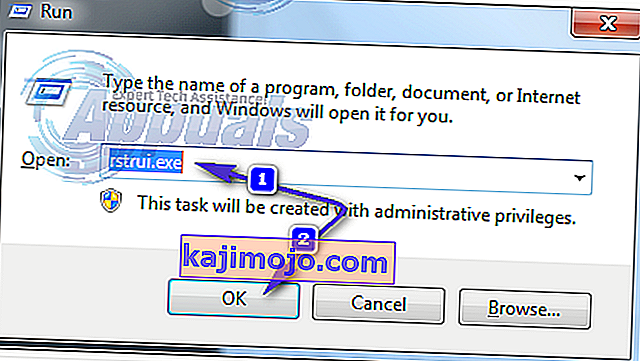
- ในหน้าต่าง System Restore ให้เลือกเลือกจุดคืนค่าอื่นแล้วกดNext
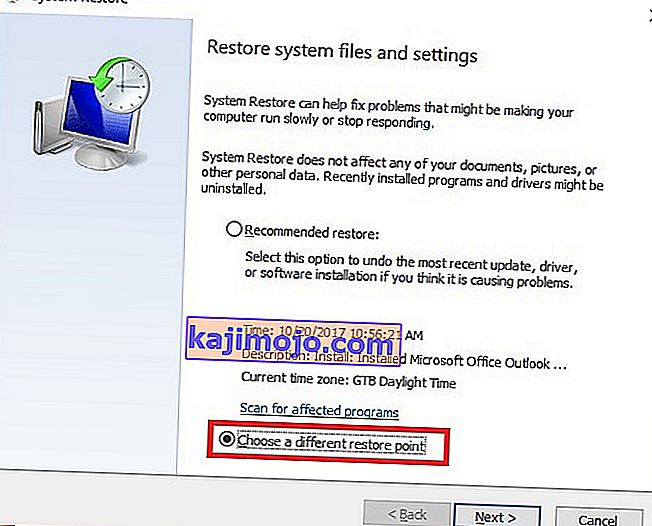
- หนากล่องข้างShow More Restore Points
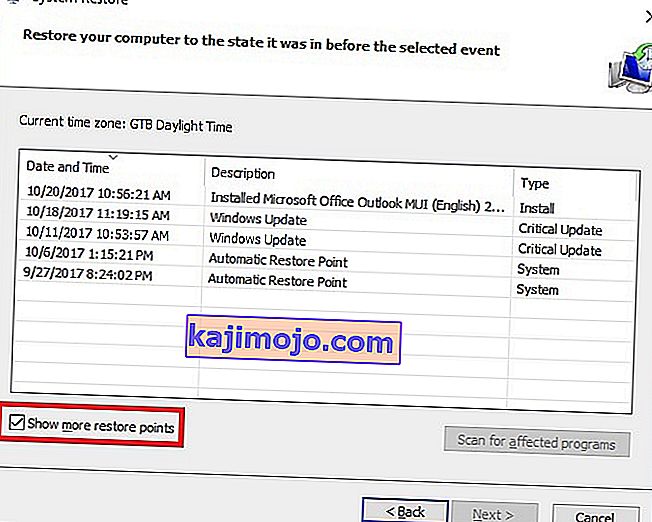
- ค้นหาจุดที่ Outlook กำลังทำงานจากนั้นเลือกจุดคืนค่านั้นและดำเนินการตามคำแนะนำบนหน้าจอเพื่อคืนค่าคอมพิวเตอร์กลับเป็นเวลาก่อนหน้า
- Once this is done, the system will begin restoring. After the restore has finished, check to see if Outlook works. if it doesn’t, then proceed to Method 3.
Method 3: Restore to a previous version of Outlook
If restoring your desktop OS to an earlier version didn’t work, let’s try restoring Outlook to a previous version. Here’s how:
- Click Start and type Outlook.exe in the search dialog. Right-click on it and choose Properties.
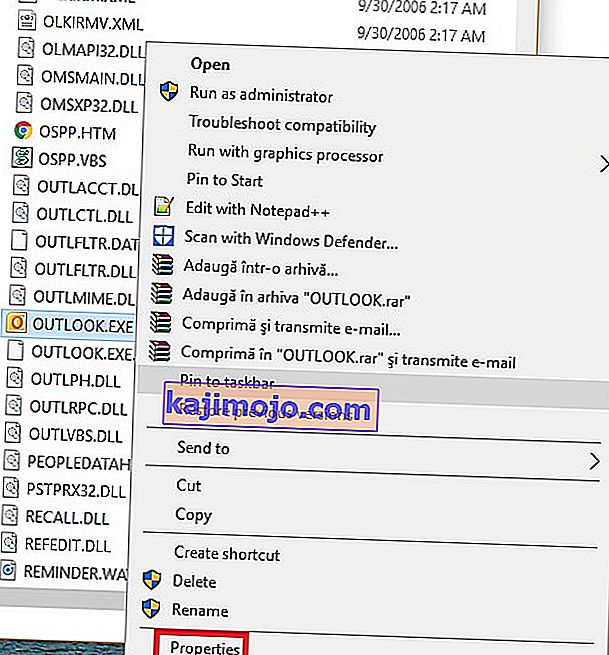
- Then go to the Previous Versions tab, and locate the Outlook.exe file that has a date when it worked. Click Open to see if it works and opens without Safe Mode.
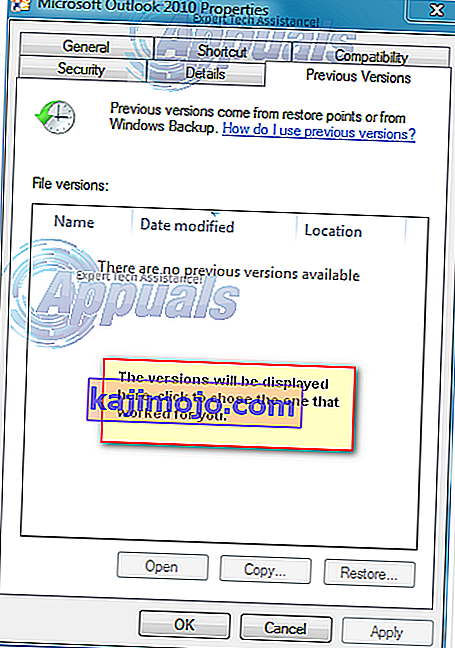 Note: Make sure the non-working Outlook that previously opened in Safe Mode is closed because we are now running one of the copies saved in the previous versions. Do the same for all versions listed there. Open/Close until you see the one that opens without Safe Mode. If it does work, then keep the Window open.
Note: Make sure the non-working Outlook that previously opened in Safe Mode is closed because we are now running one of the copies saved in the previous versions. Do the same for all versions listed there. Open/Close until you see the one that opens without Safe Mode. If it does work, then keep the Window open. - Assuming that you now have the version of Outlook running, without Safe Mode from one of the previous versions. Hold the Windows Key and Press R. Type taskmgr and click OK.
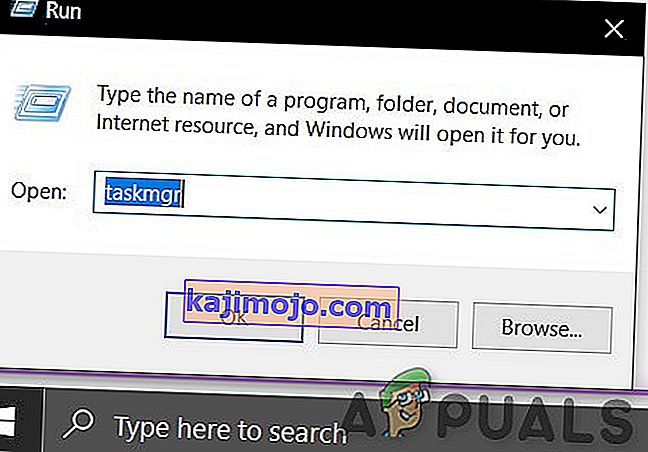
- In the Task Manager Window, Go to the Process Tab, locate Outlook.exe, right-click on it and choose Open File Location.
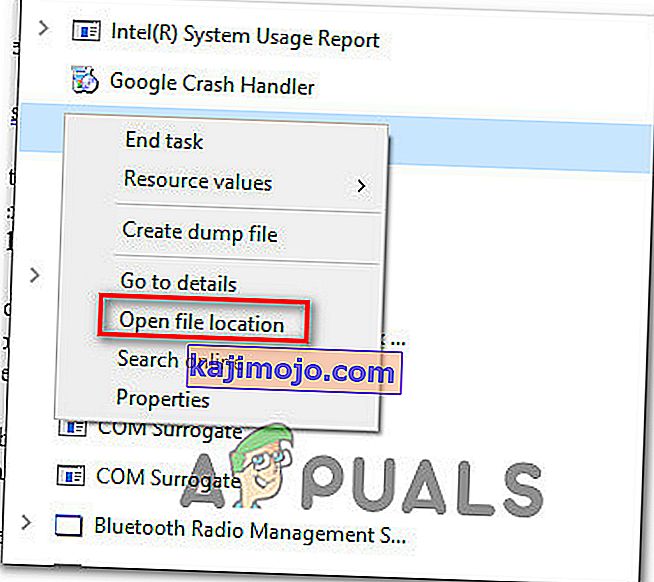
- Copy all the files from the next window, then navigate to C:\Program Files (x86)\Microsoft Office\Office. Paste the filed previously copied here.
- Try to re-open Outlook and see if it starts in normal mode.
Method 4: Uninstalling the KB3114409 update ( Outlook 2010)
Sometime in 2015, Microsoft issued a security patch that caused Outlook to run in Safe Mode and revert it back to the default configuration. The user-made configurations aren’t lost forever and will be back when Outlook manages to boot up in normal mode.
If you have this problem, there are two ways to proceed forward. Since Microsoft issued an update that fixes the problem caused by KB3114409, we can install that over the bad update. A different route would be to simply uninstall the KB3114409.
We highly recommend you to go for installing the official Microsoft update fix. But regardless of which option you opt for, we will guide you through the whole process.
Using the official Microsoft fix
Microsoft update KB3114560 was issued specifically to fix the damage done by KB3114409. As a rule of thumb, you should always install security updates from the official website. Here’s what you need to do:
- Access this official link and click on one of the two different update versions, according to your PC specs.
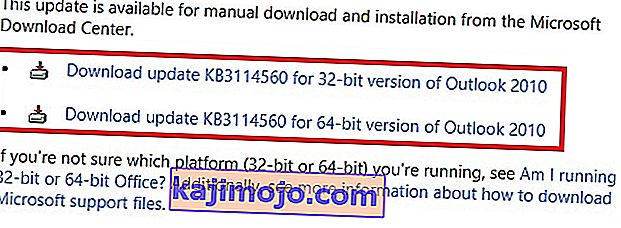
- Select the default language of your Outlook program and click on the Download button.
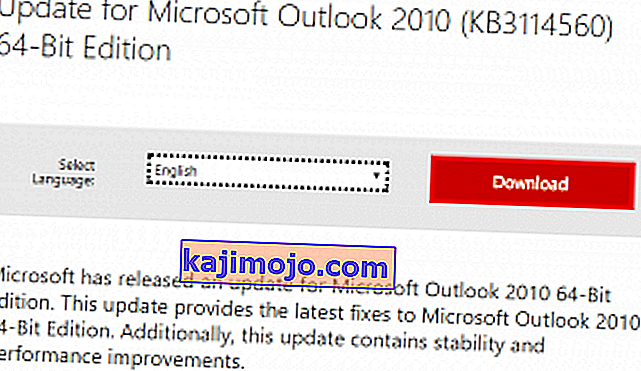
- Once the update has been downloaded, open the executable and follow through with the installation process.
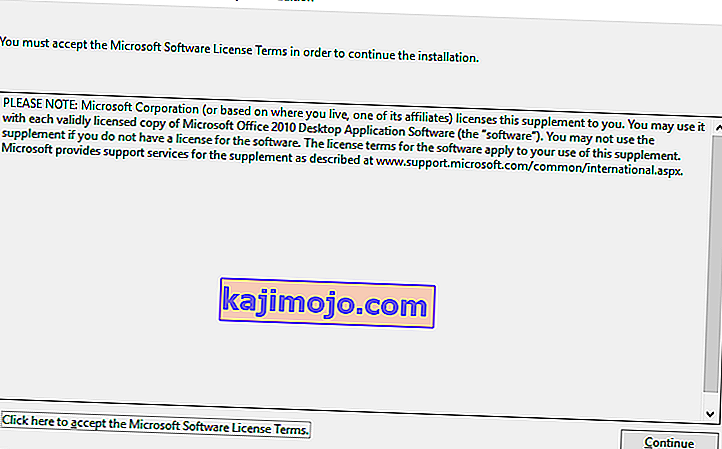
- Restart your PC, open Outlook again and see if the issue has been resolved.
Uninstalling the KB3114409 update
- Close Outlook completely.
- Open Control Panel, click on Uninstall a program.
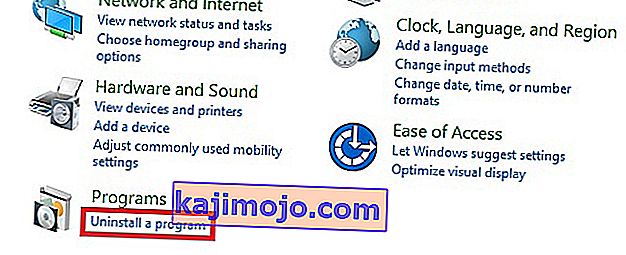
- Once you’re in the Programs and Features window, click on View installed updates.
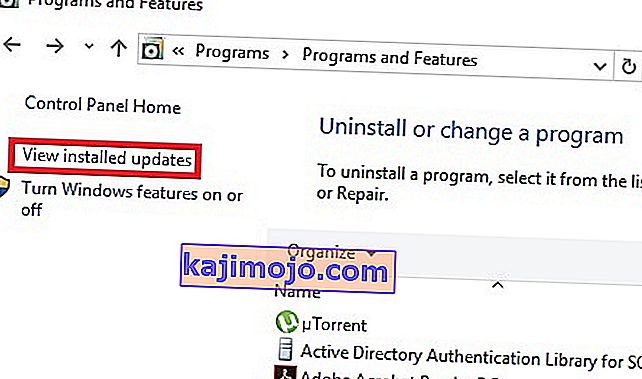
- Use the Search Installed Updates search bar in the top-right corner to search for the bad update (KB3114409 ).

- Once you manage to identify the bad update, click the Uninstall button and follow through with the confirmation prompts.
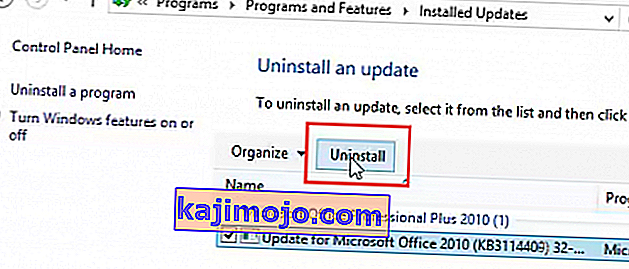
- Restart your PC, open Outlook and see if the issue repeats.
Method 5: Doing an Outlook Profile reset (All Outlook versions)
If you experience hanging at the initial Outlook splash screen (right before it initiates Safe Mode), you might need to do a profile reset. Here’s how to do it:
- Go to Control Panel > Mail and click on Show Profiles.
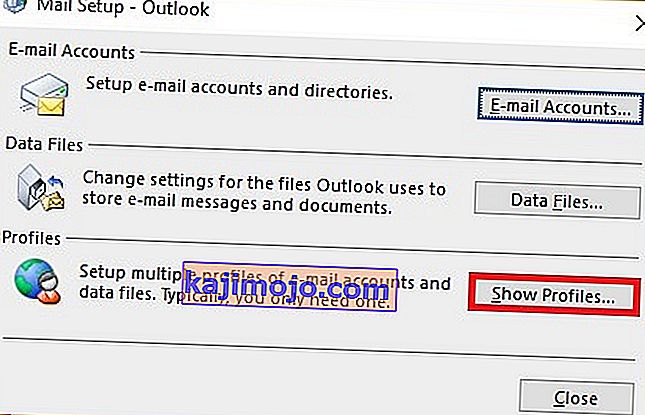
- Now, create a new profile by clicking the Add button. Insert a name and hit OK.
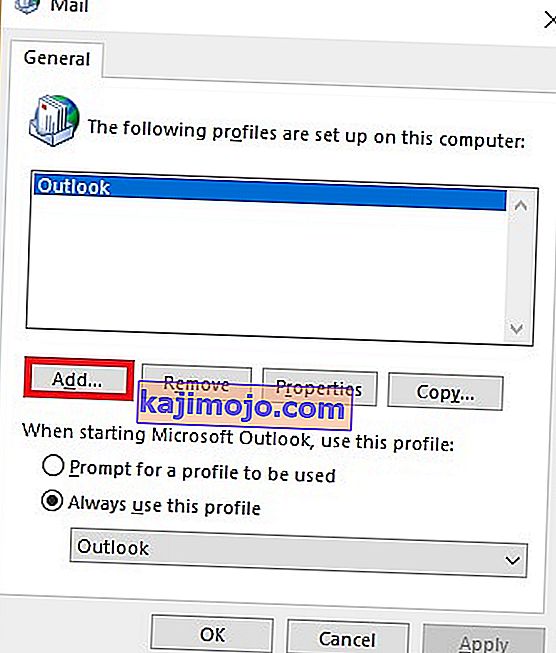
Note: Do not delete the original profile, because we don’t know if this will end up fixing the issue.
- Go through the steps of configuring your email account with Outlook. Make sure to use the same email that you have on the already created profile.
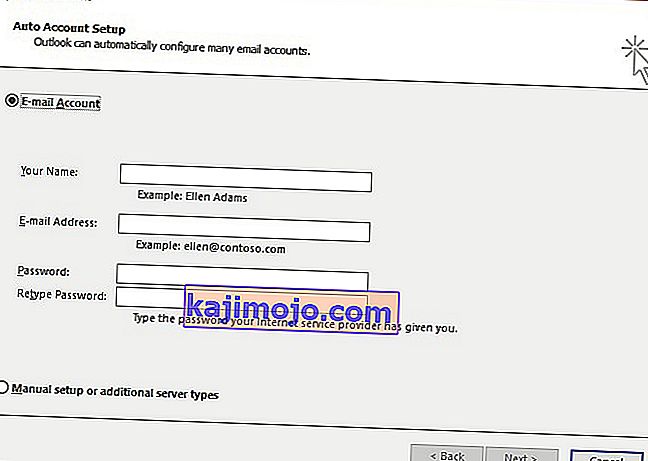
- Now return to the Mail window and make sure the profile you’ve just created is being used by default. Hit Apply to confirm your selection.
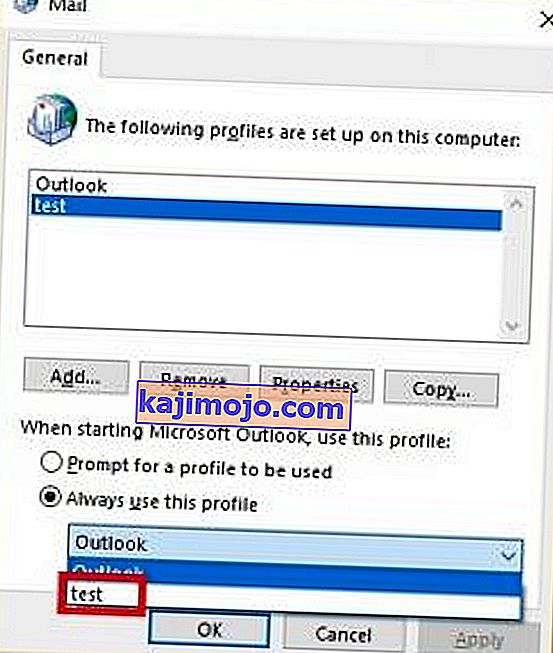
- Start Outlook again and see if it manages to start in normal mode after the profile reset.
Method 6: Checking the PST folder for corruption (All Outlook versions)
Another common cause for Outlook starting in Safe Mode is the Personal Folders File (PST). In the event that it becomes very large, or some files inside are corrupted, it might prevent the program from starting in normal mode. Luckily, you can easily check for corruption by using a Microsoft Repair tool called Scanpst.exe. Here’s what you need to do:
- Close Outlook completely and navigate to C:\ Program Files or C:\ Program Files (x86), depending on which version of Outlook you use.
- Use the search box in the top-right corner to search for SCANPST.exe.
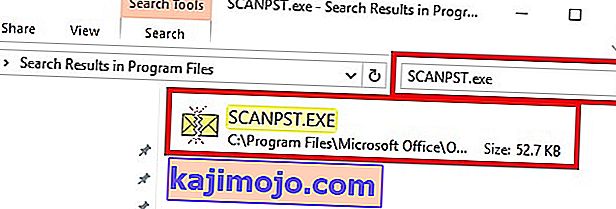 Note: If you don’t manage to find the SCANPST executable via the search bar, you need to navigate to the exact location. Here’s a list of the exact locations based on various Outlook versions:
Note: If you don’t manage to find the SCANPST executable via the search bar, you need to navigate to the exact location. Here’s a list of the exact locations based on various Outlook versions:2016: C:\Program Files (x86)\Microsoft Office\root\Office16 2013: C:\Program Files (x86)\Microsoft Office\Office15 2010: C:\Program Files (x86)\Microsoft Office\Office14 2007: C:\Program Files (x86)\Microsoft Office\Office12
- Open SCANPST.exe and set the path of the PST file you want to scan by using the Browse button. By default, the PST files are stored in Documents\Outlook Files. When you are ready, hit Start to begin the scan.
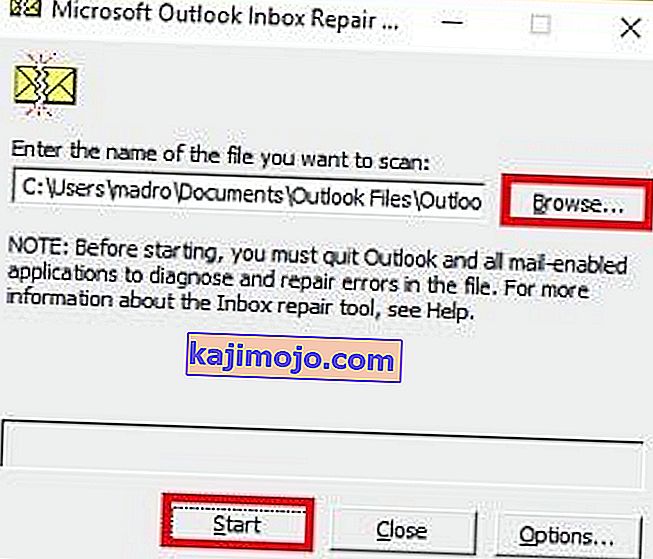
- If the scan uncovers errors or inconsistencies, click on the Repair button to fix them.
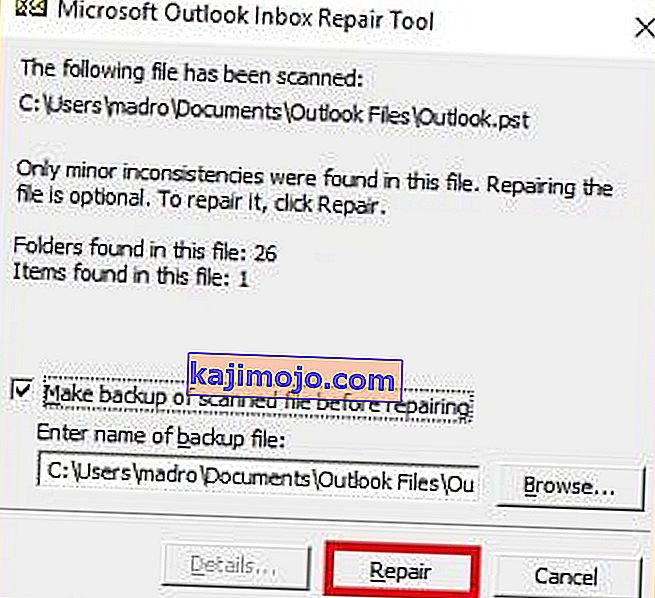
- Once the repair is done, restart Outlook with the profile that you’ve just repaired of errors and see if it starts in normal mode.
Method 7: Running the /resetnavpane command (All Outlook versions)
The navigation pane is that left portion of Outlook where you can oversee your folder list and access various icons to move between calendar, people, tasks, and mails. Sometimes, it can become glitched and prevent Outlook from starting in normal mode. Luckily, there is a command that removes any customizations to the navigation pane and gets rid of any glitch. Even better, this is done outside Outlook with ease. Here’s how:
- Close Outlook completely.
- Go to Start and access the Run application.
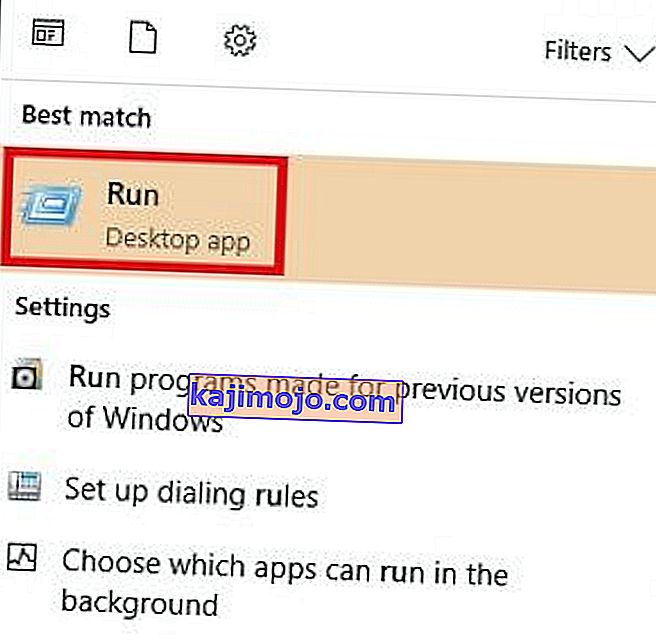
- Now, type Outlook.exe /resetnavpaneand hit OK.
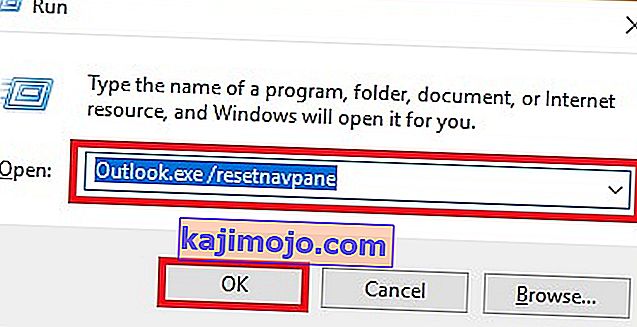 Note: Keep in mind that any customization to the navigation pane will be lost after you click on OK.
Note: Keep in mind that any customization to the navigation pane will be lost after you click on OK. - Shortly after, Outlook should automatically open in normal mode.
Method 8: Disabling compatibility mode
A lot of users have reported that they managed to start Outlook in normal mode after finding out it was running in compatibility mode. Compatibility mode is designed to help a program run as if it was running on an older operating system. As it turns out, turning off compatibility mode might just fix your Outlook Safe Mode problem. Here’s how:
- Close Outlook and navigate to the Outlook.exe on your computer. The exact path of it will differ, depending on your Outlook version. Here’s a list of the exact paths depending on your Outlook version:
2016 - C:\Program Files (x86)\Microsoft Office\root\Office16 2013 - C:\Program Files (x86)\Microsoft Office\Office 15 2010 - C:\Program Files (x86)\Microsoft Office\Office 14 2007: C:\Program Files (x86)\Microsoft Office\Office12

- Right-click on Outlook.exe and click on Properties.
- Now click on the Compatibility tab and make sure the box directly under Compatibility Mode is unchecked. Hit Apply to confirm your selection.
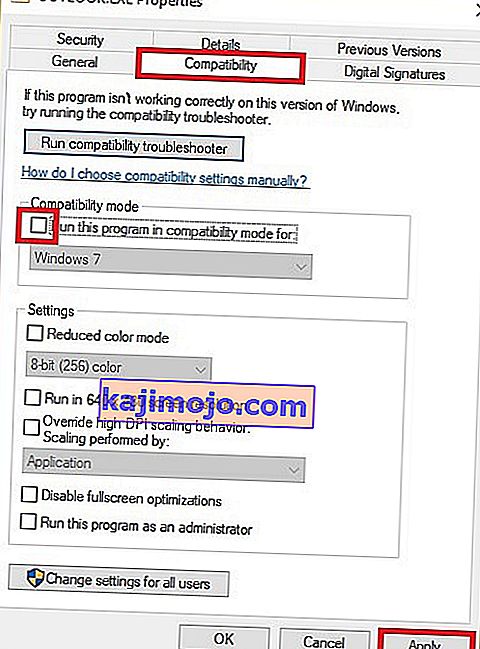
- Finally, open Outlook from the same Outlook executable and see if it manages to start in normal mode.
Method 9: Disabling hardware acceleration (All Outlook versions)
As it turns out, Outlook tries to use hardware acceleration whenever it can to make things as seamless as possible. If you’re Outlook forces itself into Safe Mode, it could very well be an issue with hardware acceleration. We can check to see if that’s the case by making some minor tweaks inside regedit. Here’s how:
- Go to Start and open the Run application.
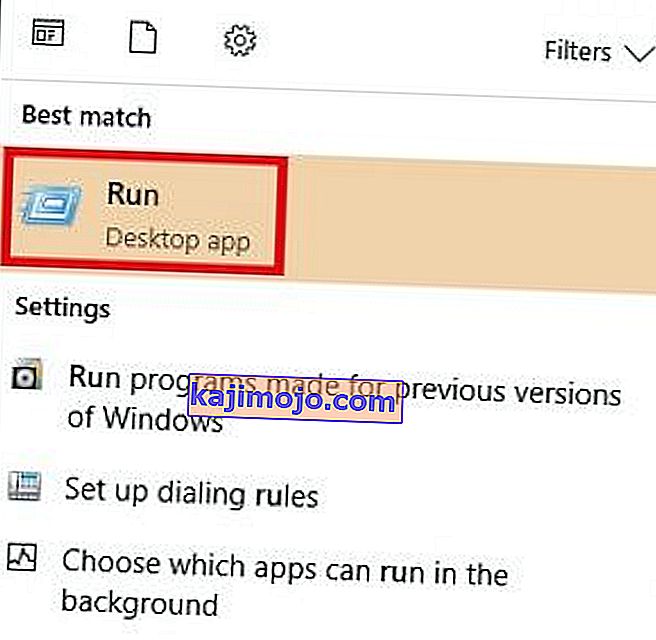
- Search for regedit and click OK to open the Registry Editor.

- Navigate your way to the following location
HKEY_CURRENT_USER\ Software\ Microsoft\ Office.
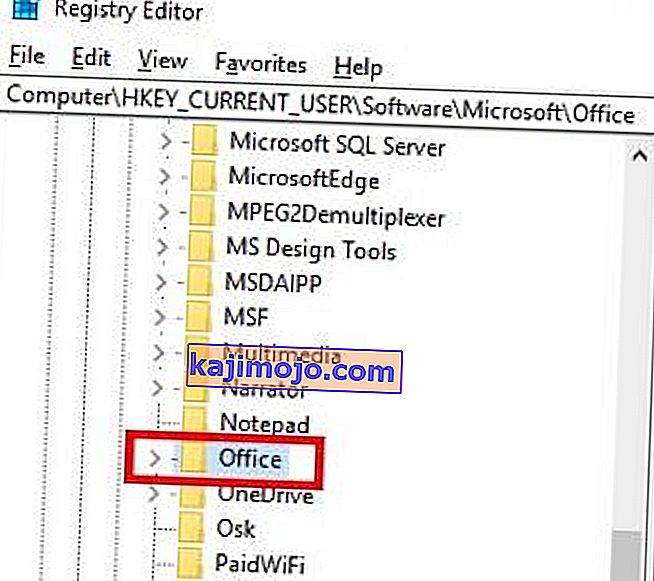
- Now, depending on which Outlook version you have, you might encounter different folders. You should either see a folder named 14.0, 16.0 or 8.0. Either way, click on the folder and double-click on the Common folder.
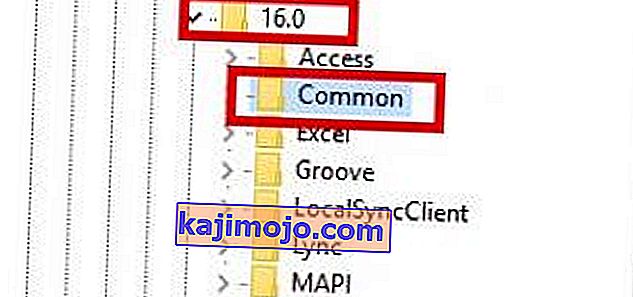
- Right-click anywhere in the Common folder, select New and click on Key and name it Graphics.
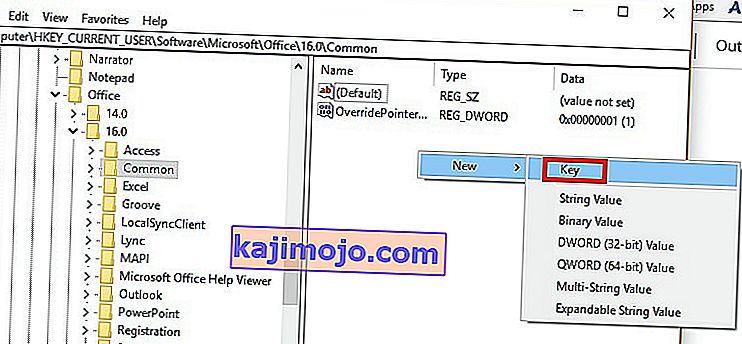
- Select the newly created Graphics folder and right-click on the right panel. From there, create a New Dword (32-bit) Value and name it DisableHardwareAcceleration.
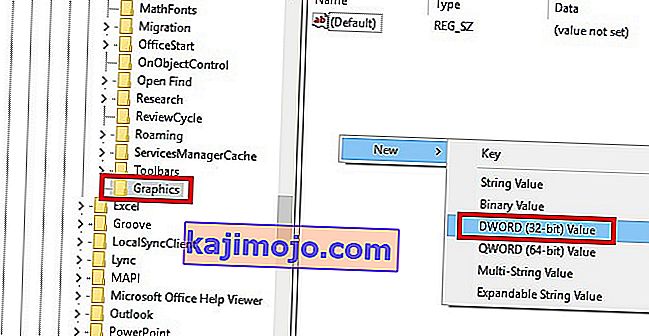
- Now double-click on DisableHardwareAcceleration and set the Value Data to 1 and hit Ok.
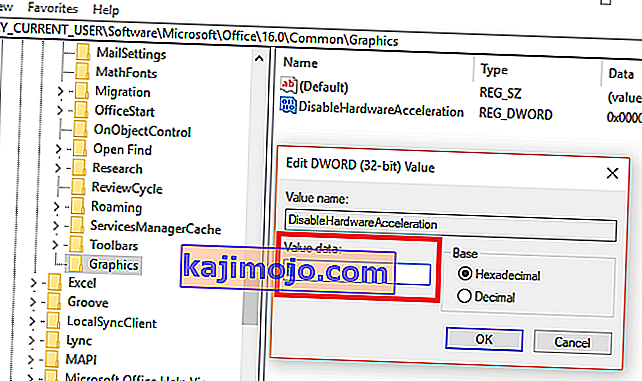
- Close regedit and open Outlook again to see if it starts in normal mode.
Method 10: Resetting the Safe Mode Registry Key (Outlook 2010)
If you have unsuccessfully followed all the methods above, there’s one more thing you can try. A final solution would be to try and prevent Safe Mode from kicking in by tweaking the registry key. But keep in mind that after you’ll follow the steps below, you won’t be able to use Safe mode in the future. At least not until you remove the key that we will create. Here’s what you need to do:
- Go to Start and open the Run application.

- Search for regedit and click OK.

- Navigate your way through HKEY_CURRENT_USER\ Software\ Microsoft\ Office.

- Now, depending on which Outlook version you have, you might encounter different folders. You should either see a folder named 14.0, 16.0 or 8.0. Either way, click on the folder navigate further to Outlook \ Security.
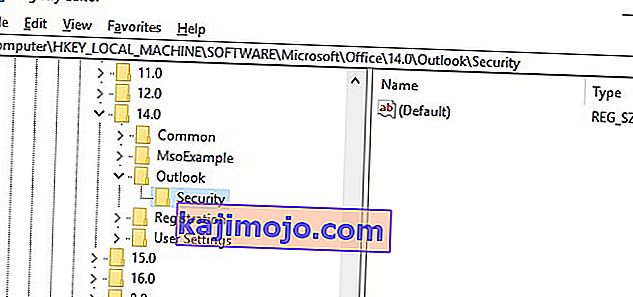 Note: If the Security folder is missing, Right-click > New > Key and type Security.
Note: If the Security folder is missing, Right-click > New > Key and type Security. - Right-click on the Security key and choose New > then DWORD (32-bit) Value.
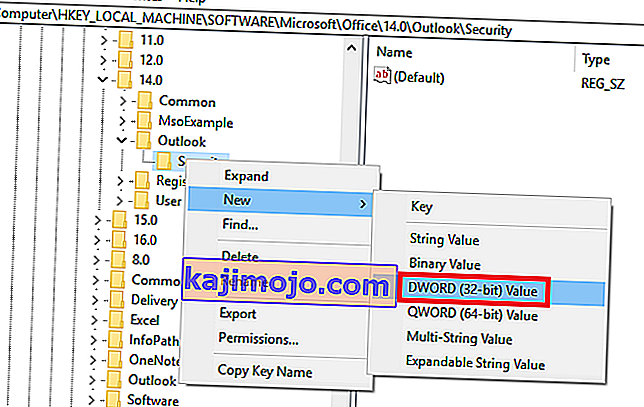
- Name it DisableSafeMode and press Enter to confirm.
- Right-click on DisableSafeMode and click on Modify.
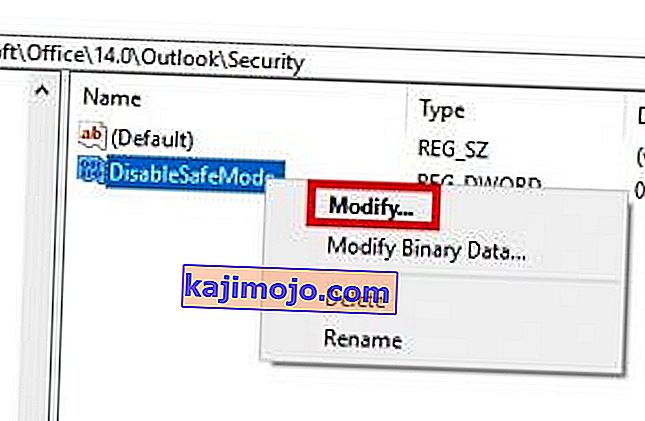
- แทรกค่า1ในข้อมูลค่ากล่องและคลิกตกลง

- ออกจากRegistry Editorและรีบูตเครื่องคอมพิวเตอร์ของคุณ
- เปิด Outlook และดูว่าเริ่มทำงานในโหมดปกติหรือไม่






 หมายเหตุ:อย่าตีลบเพียง แต่ ก่อนอื่นเราต้องยืนยันว่าพวกเขาเป็นสาเหตุของปัญหา
หมายเหตุ:อย่าตีลบเพียง แต่ ก่อนอื่นเราต้องยืนยันว่าพวกเขาเป็นสาเหตุของปัญหา




 Note: Make sure the non-working Outlook that previously opened in Safe Mode is closed because we are now running one of the copies saved in the previous versions. Do the same for all versions listed there. Open/Close until you see the one that opens without Safe Mode. If it does work, then keep the Window open.
Note: Make sure the non-working Outlook that previously opened in Safe Mode is closed because we are now running one of the copies saved in the previous versions. Do the same for all versions listed there. Open/Close until you see the one that opens without Safe Mode. If it does work, then keep the Window open.












 Note: If you don’t manage to find the SCANPST executable via the search bar, you need to navigate to the exact location. Here’s a list of the exact locations based on various Outlook versions:
Note: If you don’t manage to find the SCANPST executable via the search bar, you need to navigate to the exact location. Here’s a list of the exact locations based on various Outlook versions:


 Note: Keep in mind that any customization to the navigation pane will be lost after you click on OK.
Note: Keep in mind that any customization to the navigation pane will be lost after you click on OK.








 Note: If the Security folder is missing, Right-click > New > Key and type Security.
Note: If the Security folder is missing, Right-click > New > Key and type Security.

